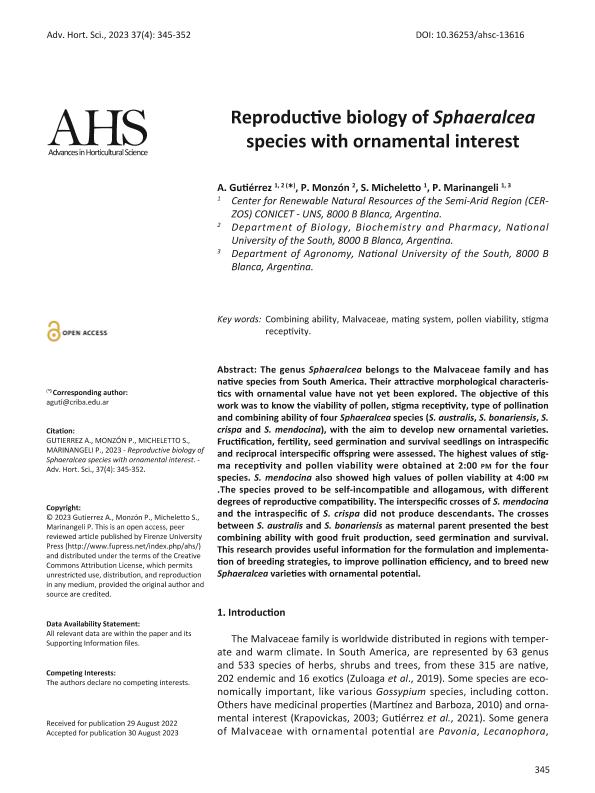Artículo
Reproductive biology of Sphaeralcea species with ornamental interest
Fecha de publicación:
18/01/2024
Editorial:
Firenze University Press
Revista:
Advances in Horticultural Science
ISSN:
1592-1573
Idioma:
Inglés
Tipo de recurso:
Artículo publicado
Clasificación temática:
Resumen
The genus Sphaeralcea belongs to the Malvaceae family and hasnative species from South America. Their attractive morphological characteristics with ornamental value have not yet been explored. The objective of thiswork was to know the viability of pollen, stigma receptivity, type of pollinationand combining ability of four Sphaeralcea species (S. australis, S. bonariensis, S.crispa and S. mendocina), with the aim to develop new ornamental varieties.Fructification, fertility, seed germination and survival seedlings on intraspecificand reciprocal interspecific offspring were assessed. The highest values of stigma receptivity and pollen viability were obtained at 2:00 PM for the fourspecies. S. mendocina also showed high values of pollen viability at 4:00 PM.The species proved to be selfincompatible and allogamous, with differentdegrees of reproductive compatibility. The interspecific crosses of S. mendocinaand the intraspecific of S. crispa did not produce descendants. The crossesbetween S. australis and S. bonariensis as maternal parent presented the bestcombining ability with good fruit production, seed germination and survival.This research provides useful information for the formulation and implementation of breeding strategies, to improve pollination efficiency, and to breed newSphaeralcea varieties with ornamental potential.
Archivos asociados
Licencia
Identificadores
Colecciones
Articulos(CERZOS)
Articulos de CENTRO REC.NAT.RENOVABLES DE ZONA SEMIARIDA(I)
Articulos de CENTRO REC.NAT.RENOVABLES DE ZONA SEMIARIDA(I)
Citación
Gutierrez, Agustina; Monzón, María Paula; Micheletto, Sandra; Marinangeli, Pablo Alejandro; Reproductive biology of Sphaeralcea species with ornamental interest; Firenze University Press; Advances in Horticultural Science; 37; 4; 18-1-2024; 345-352
Compartir
Altmétricas




